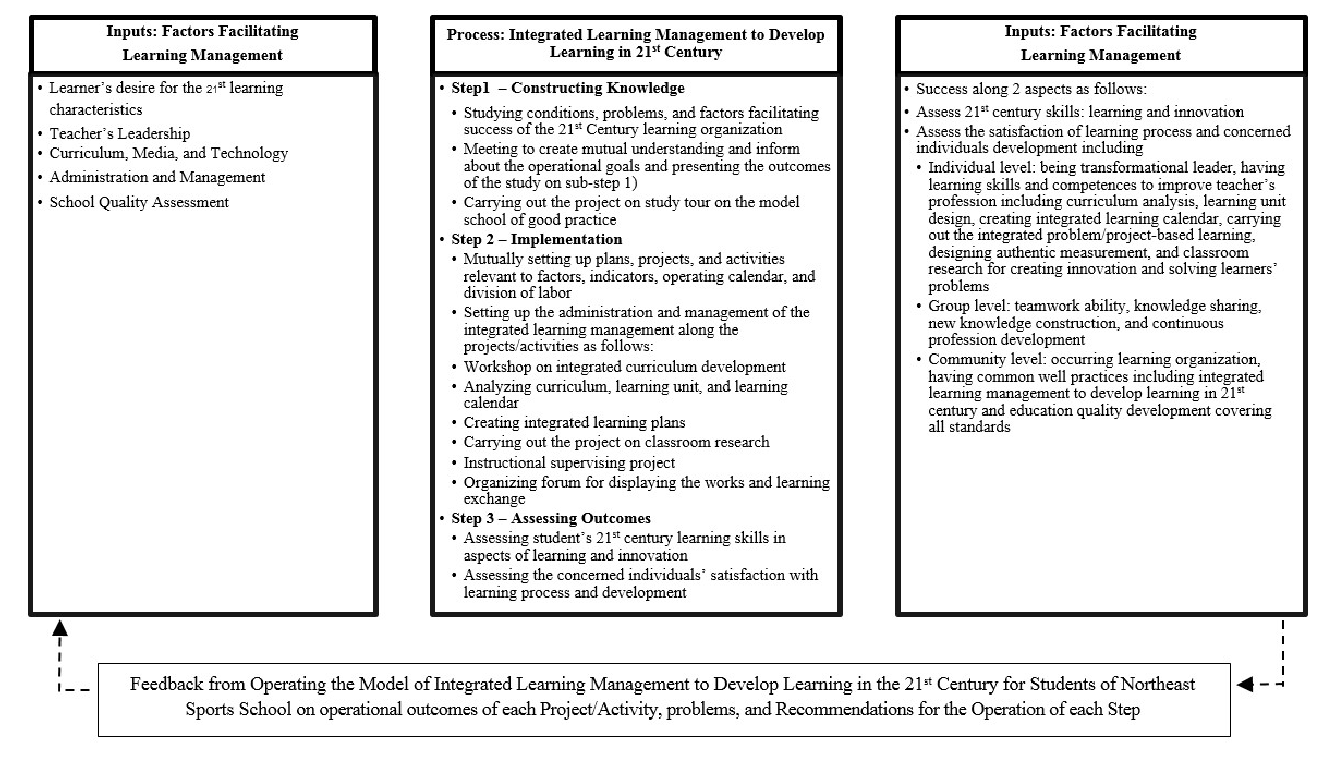The model of integrated learning management to develop learning in the 21st century for students of Northeast Sports School
Main Article Content
Abstract
This paper aimed to study and develop 21st century learning of sport students in the Northeast of Thailand. Integrated learning management model was created and verified through research and development design. The findings revealed that the integrated learning management model for developing 21st century learning acquired along the open system approach for administration with the unitary integration of factors, namely, factors to facilitate the success 1) Inputs which included desirable characteristics of learners in 21st century, teacher's leadership, curriculum, media and technology, and education quality management and assessment, 2) Process including step 1- creating knowledge framework, step 2 - putting into practice, step 3 - outcome assessment, 3) Output - the success along the factors, and 4) Feedback - the reflection on problems and recommendations for operating in each step. The integrated learning management model for developing 21st century learning concerned individuals had satisfaction with it at most levels.
Article Details
References
A. Bryk,E. Camburn, K. S. Louise, Professional learning in Chicago Elementary School: Facilitating factors and organizational consequences, Educational Administration Quarterly 35 (1999), 751 -- 781.
L. J. Cronbach, Essential of psychological testing, New York: Harper & Row, 1974.
R. Duangkaew, Educational quality development. In Research of education administration, Sukhothai Thammathirat Open University, 2013.
C. Forde, M. McMahon, A. McPhee, F. Patrick, Professional development, reflection and enquiry. London: Paul Chapman Publishing, 2006.
H. Morteza, A. O. Sahim, Optimization of encapsulated clove oil particle size with biodegradable shell using design expert methodology, Pakistan Journal of Biotechnology 12(2) (2015) 149 - 160.
H. Q. Nguyen, et al., A Matlab-based simulation program for indoor visible light communication system, in Proceeding of The 7th International Symposium on Communication Systems, Networks $&$ Digital Signal Processing (CSNDSP 2010), 2010, pp. 537 - 541.
K. Karomprach, Participatory action research of executor, Office of human resource development program, Ministry of Education, 2004.
S. Kemmis, R. McTaggart, The action research planner (3rd ed.). Geelong: Deakin University Press, 1988.
F. C. Lunenburg, A. C. Ornstein, Educational administration. 2nd ed. California: Wadsworth, 1996.
C. Na-Lampoon, Integrated administration model to enhance participating schools in the world class standard school project, Interdisciplinary Research Review, 14(3) (2019) 47 - 53.
Office of the basic education commission, OBEC record 2008, National Office of Buddhism Press, 2008.
Office of the Education Council, Developing Characteristics of New Era Learners to Facilitate the 2nd Decade of Education Reform via Applying ICT in to Carry out Project-based Learning, Bangkok: Office of the Education Council, 2014.
V. Panich, Leadership of new era organization, The Knowledge Management Institute Journal 12(9) (2011) 114-115.
Pollution problems from the textile industry, http:// www.thaiwasteexchange.net/knowledge/pdf/file2132f3b4beee9 6ba0500dfdd069d2e.pdf (accessed 28 October 2017).
S. Prabudhanitisar, Participatory action research : concepts and practice, The Thailand Research Fund Press, 2014.
B. Srisa-aad, Basic Research, 9th Printing. Bangkok: Suweeriyasan, 2011.
W. Sutthinarakorn, Participatory action research and conscientization, Sayam Press, 2014.
bibitem{1}
S. H. Zhu, et al., Telephone counseling for smoking cessation: Effects of single-session and multiple-session interventions, Journal of Consulting and Clinical Psychology 64(1) (1996) 202 - 211.
T. Uppamaiathichai, Fundamental of educational management, Chulalongkorn University Press, 2014.
Z. Lubin, B. Dominic, M. Hoa Le, L. Kyungwoo, J. Daekwang, O. Yunje, Improvement of date rate by using equalization in an indoor visible light communication system, in Proceeding of IEEE International Conference on Circuits and Systems for Communications, 2008, pp. 678 - 682.


